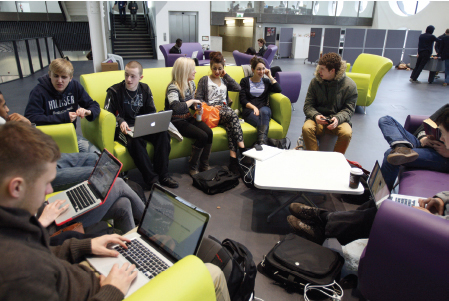Media Convergence
Printed Page 9
The electronic and digital eras have ushered in the phenomenon of media convergence, a term that has two very different meanings. According to one meaning, media convergence is the technological merging of content in different mass media. For example, magazine articles and radio programs are also accessible on the Internet. And songs, TV shows, and movies are now available on computers, iPods, and cell phones.

Such technological convergence is not entirely new. For instance, in the late 1920s, the Radio Corporation of America (RCA) purchased the Victor Talking Machine Company and introduced machines that could play both radio and recorded music. However, contemporary media convergence is much broader because it involves digital content across a wider array of media.
The term media convergence can also be used to describe a particular business model by which a company consolidates various media holdings—such as cable connections, phone services, television transmissions, and Internet access—under one corporate umbrella. The goal of such consolidation is not necessarily to offer consumers more choices in their media but to better manage resources, lower costs, and maximize profits. For example, a company that owns TV stations, radio outlets, and newspapers in multiple markets—as well as in the same cities—can deploy one reporter or producer to create three or four versions of the same story for various media outlets. The company therefore can employ fewer people than if it owned only one media outlet.
The convergence business model offers more profits to those companies that downsize—or converge—their workforce while increasing their media holdings in many markets. But while it’s easy to see the benefits for media owners, this model presents serious disadvantages for society. It limits the range of perspectives from which messages are delivered, as media content becomes concentrated in fewer and fewer hands. For instance, as conglomerates buy up more and more newspapers and employ fewer reporters, citizens are exposed to a narrower range of interpretations of news events. Simultaneously, media owners’ personal biases and interests—for example, in culture, politics, and economics—gain more influence. That’s because the content they control gets disseminated more widely than content controlled by smaller companies or media outlets.
Both forms of convergence are changing the ways media are distributed and consumed. While much media content is still produced by traditional media industries (the music industry, the film industry, the publishing industry, and so forth), distribution channels have expanded to include a great variety of services and devices. This in turn has caused an ongoing economic shift, where cable and Internet providers, cell phone companies, and digital retailers like Amazon or iTunes receive a greater share of the money spent on media consumption, while traditional outlets like movie theaters, book stores, and record labels may struggle. Media consumption still absorbs a massive amount of time and money, but convergence ensures that this time and money will be flowing in new, different directions.